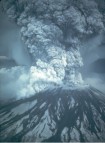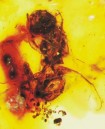
Publisher:
Bonnie King
CONTACT:
Newsroom@Salem-news.com
Advertising:
Adsales@Salem-news.com

~Truth~
~Justice~
~Peace~
TJP
Jurassic Crocodile Surfaces from the Blue Mountains in Eastern Oregon
Salem-News.comThe remains of the crocodile, believed to be from the species Thalattosuchia and member of the Metriorhynchids group, now belong to the state.
(EUGENE) -  An ancient sea-going crocodile has surfaced from the rocks of Crook County in eastern Oregon.
An ancient sea-going crocodile has surfaced from the rocks of Crook County in eastern Oregon.
Its discovery by the North American Research Group, whose members were digging for Jurassic-age mollusks known as ammonites, is another confirmation that the Blue Mountains consist of rocks that traveled from somewhere in the Far East, says retired University of Oregon geologist William Orr, who was called in to examine the find for the state.
The remains – about 50 percent of a 6 to 8-foot reptile, including long, needlepoint teeth – were found imbedded in Jurassic rock on private property in the Snowshoe Formation of the Izee Terrane south of Dayville, Ore.
Western Oregon University Welcomes the Oregon Academy of Science
Salem-News.comThe OAS meeting will begin Saturday at 7:00 AM with registration at Werner University Center.
(MONMOUTH) -  Western Oregon University will host the 65th annual meeting of the Oregon Academy of Science on Saturday, February 24, 2007. The OAS promotes science education and scientific research within the state. The academy's thirteen sections work to encourage communication among Oregon scientists, both private and public and fosters the growth of tomorrow's scientists through the junior academy for high school students.
Western Oregon University will host the 65th annual meeting of the Oregon Academy of Science on Saturday, February 24, 2007. The OAS promotes science education and scientific research within the state. The academy's thirteen sections work to encourage communication among Oregon scientists, both private and public and fosters the growth of tomorrow's scientists through the junior academy for high school students.
Oregon State Study Finds Gas Movement Key to Mount St. Helens Eruptions
Salem-News.comIn September of 2004, Mount St. Helens had some of its first significant explosions and dome building since 1986.
(CORVALLIS) -  A study being published this week suggests that gas and vapor movement to the top of the magma body may have caused fairly rapid increases in pressure and could have been the triggering mechanism that caused Mount St. Helens to erupt in both 1980 and 2004.
A study being published this week suggests that gas and vapor movement to the top of the magma body may have caused fairly rapid increases in pressure and could have been the triggering mechanism that caused Mount St. Helens to erupt in both 1980 and 2004.
Oregon Astronaut Don Pettit Goes to Antarctica
Dr. Tony Phillips Science@NASAOregon Native Don Pettit joins ANSMET team in Antarctica.
(NASA) -  "We're on a bit of an adventure," explains Don. "I've joined a scientific expedition to Antarctica to hunt for meteorites. The name of the expedition is ANSMET, short for Antarctic Search for Meteorites, and it is funded by the National Science Foundation and operated by principal investigators from Case Western University. ANSMET has been making annual trips to Antarctica since the mid-70s. The scientific value is immense. More than 10,000 meteorites have been found including such jewels as the famous Allan Hills meteorite from Mars.”
"We're on a bit of an adventure," explains Don. "I've joined a scientific expedition to Antarctica to hunt for meteorites. The name of the expedition is ANSMET, short for Antarctic Search for Meteorites, and it is funded by the National Science Foundation and operated by principal investigators from Case Western University. ANSMET has been making annual trips to Antarctica since the mid-70s. The scientific value is immense. More than 10,000 meteorites have been found including such jewels as the famous Allan Hills meteorite from Mars.”
"I was fortunate enough to be asked to tag along as the token astronaut," he laughs. "Why me? It was mainly dumb luck. One of the ANSMET scientists dropped out at the last minute for medical reasons. Because the principal investigator had dealt with astronauts before, he knew they would not have trouble passing the medical exam and could be called up on short notice. When my boss asked me if I wanted to go, I thought about it for perhaps a nanosecond and said yes!"
"So here I am in Antarctica with the ANSMET team looking for little chunks of extra-terrestrial debris that just happened to rain down on the Antarctic continent where the glaciers have this amazing habit of concentrating them well beyond their natural abundance."
Era of High-Speed Optical Computing is Approaching
SAlem-News.com Tech NewsThe speed of electronic devices, the researchers said, is already starting to hit a wall based on the physical limitations of how fast electrons can move.
(CORVALLIS) -  Physicists at Oregon State University have discovered a way to manipulate the transmission of optical signals in tiny wires, dramatically slowing, stopping or even speeding them up to velocities faster than the speed of light – a major advance that could open the door to a new era of computing and information processing based on optics.
Physicists at Oregon State University have discovered a way to manipulate the transmission of optical signals in tiny wires, dramatically slowing, stopping or even speeding them up to velocities faster than the speed of light – a major advance that could open the door to a new era of computing and information processing based on optics.
Lunar Leonid Strikes
Dr. Tony Phillips Science@NASAMeteoroids are smashing into the Moon a lot more often than anyone expected.
(NASA) -  That's the tentative conclusion of Bill Cooke, head of NASA's Meteoroid Environment Office, after his team observed two Leonids hitting the Moon on Nov. 17, 2006. "We've now seen 11 and possibly 12 lunar impacts since we started monitoring the Moon one year ago," says Cooke. "That's about four times more hits than our computer models predicted."
That's the tentative conclusion of Bill Cooke, head of NASA's Meteoroid Environment Office, after his team observed two Leonids hitting the Moon on Nov. 17, 2006. "We've now seen 11 and possibly 12 lunar impacts since we started monitoring the Moon one year ago," says Cooke. "That's about four times more hits than our computer models predicted."
A New Paradigm for Lunar Orbits
Trudy E. Bell Science@NASAIt's 2015. You're NASA's chief engineer designing a moonbase for Shackleton Crater at the Moon's south pole. You're also designing a com-system that will allow astronauts constant radio contact with Earth.
(NASA) -  But you know that direct transmissions won't work--not always. As seen from Shackleton Crater, Earth is below the horizon for two to three weeks each month (depending on the base's location). This blocks all radio signals, which travel line of sight.
But you know that direct transmissions won't work--not always. As seen from Shackleton Crater, Earth is below the horizon for two to three weeks each month (depending on the base's location). This blocks all radio signals, which travel line of sight.
The solution seems obvious. Simply place a satellite in a high, circular orbit going almost over the Moon's poles. Better yet, place three satellites into the same orbit 120 degrees apart. Two would always be above the lunar horizon to relay messages to and from Earth.
There's just one problem.
Oregon State Researchers Discover World’s Oldest Bee
Salem-News.comResearchers say the finding is key to learning more about the evolution of flowering plants.
(CORVALLIS) -  Researchers at Oregon State University have discovered the oldest bee ever known, a 100-million-year-old specimen preserved in almost lifelike form in amber and an important link to help explain the rapid expansion of flowering plants during that distant period. The species, named Melittosphex burmensis, is long extinct. The findings and their evolutionary significance are outlined in an article to be published this week in the journal Science.
Researchers at Oregon State University have discovered the oldest bee ever known, a 100-million-year-old specimen preserved in almost lifelike form in amber and an important link to help explain the rapid expansion of flowering plants during that distant period. The species, named Melittosphex burmensis, is long extinct. The findings and their evolutionary significance are outlined in an article to be published this week in the journal Science.
Oregon State Researchers Say Cougar Predation Important in Wildland Ecosystems
Salem-News.comThe findings are consistent, researchers say, with predictions made more than half a century ago by the famed naturalist Aldo Leopold, often considered the father of wildlife ecology.
(CORVALLIS) -  The general disappearance of cougars from a portion of Zion National Park in the past 70 years has allowed deer populations to dramatically increase, leading to severe ecological damage, loss of cottonwood trees, eroding streambanks, and declining biodiversity.
The general disappearance of cougars from a portion of Zion National Park in the past 70 years has allowed deer populations to dramatically increase, leading to severe ecological damage, loss of cottonwood trees, eroding streambanks, and declining biodiversity.
International Researchers Discover Rich Methane Field Off The Coast of India
Salem-News.comResearchers said the energy potential is still unknown.
(CORVALLIS) -  An international team of scientists looking for gas hydrates off the coast of India has discovered a pair of methane hydrate reservoirs buried in the sediment below the Bay of Bengal, and though the idea of a new energy source is tantalizing, researchers say the technology does not yet exist to make these reservoirs commercially feasible.
An international team of scientists looking for gas hydrates off the coast of India has discovered a pair of methane hydrate reservoirs buried in the sediment below the Bay of Bengal, and though the idea of a new energy source is tantalizing, researchers say the technology does not yet exist to make these reservoirs commercially feasible.
A similar field of gas hydrates was found off the coast of Oregon a few years ago, said Marta Torres, a marine geochemist at Oregon State University and an investigator on the India and Oregon expeditions.

Quick Links
DINING
Willamette UniversityGoudy Commons Cafe
Dine on the Queen
Willamette Queen Sternwheeler
MUST SEE SALEM
Oregon Capitol ToursCapitol History Gateway
Willamette River Ride
Willamette Queen Sternwheeler
Historic Home Tours:
Deepwood Museum
The Bush House
Gaiety Hollow Garden
AUCTIONS - APPRAISALS
Auction Masters & AppraisalsCONSTRUCTION SERVICES
Roofing and ContractingSheridan, Ore.
ONLINE SHOPPING
Special Occasion DressesAdvertise with Salem-News
Contact:AdSales@Salem-News.com


Salem-News.com:

Terms of Service | Privacy Policy